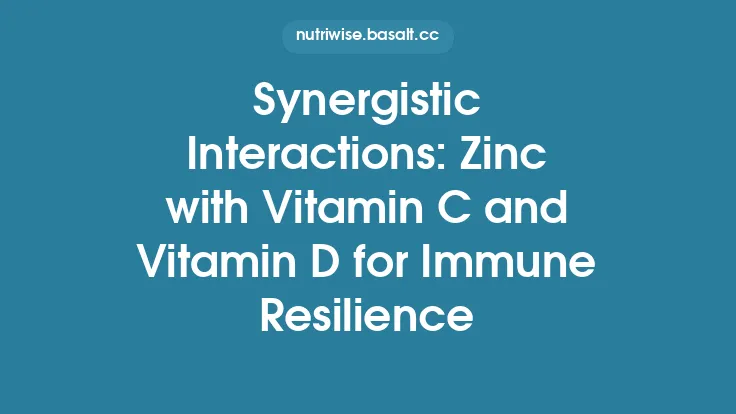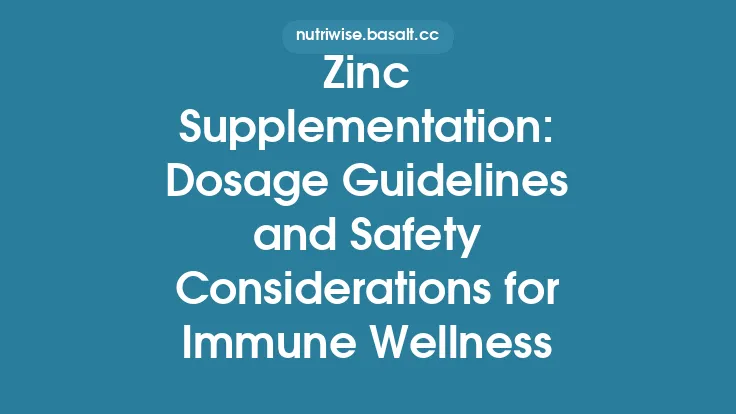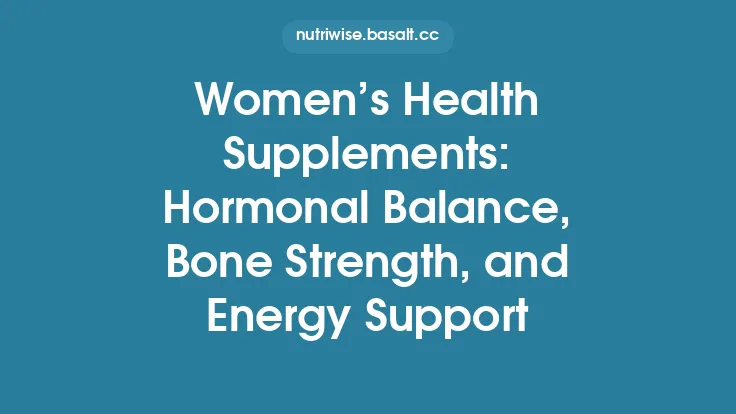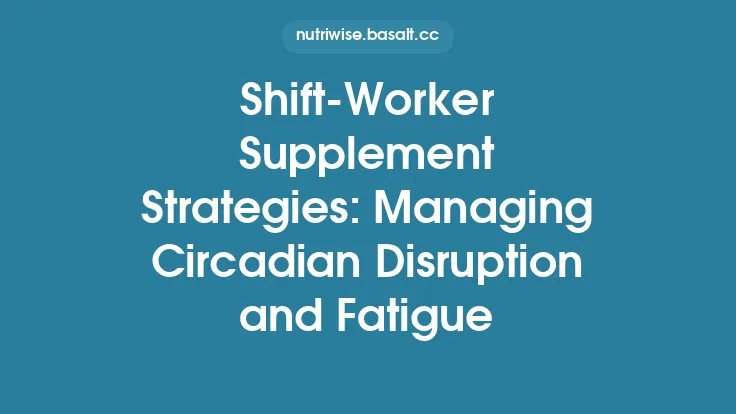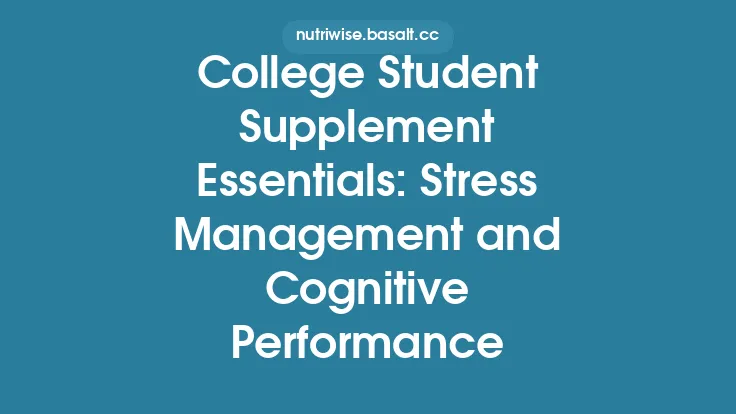Zinc is an essential trace element that plays a pivotal role in maintaining a robust immune system. Unlike many other nutrients that receive broad coverage across health literature, zinc’s specific actions on immune cells, its nuanced supplementation strategies, and the science behind its various supplemental forms merit a focused, in‑depth look. This article delves into the mechanisms by which zinc supports immunity, examines the evidence base for its therapeutic use, and outlines best‑practice guidelines for safe and effective supplementation.
Zinc’s Role in the Immune System
Zinc is integral to both innate and adaptive immunity. It acts as a structural component of over 300 enzymes and transcription factors, many of which are directly involved in immune cell development, signaling, and function. Key immune processes influenced by zinc include:
- Barrier Integrity – Zinc stabilizes epithelial tight junctions in the skin, respiratory tract, and gastrointestinal lining, reducing pathogen entry.
- Phagocyte Activity – Neutrophils and macrophages rely on zinc‑dependent enzymes (e.g., NADPH oxidase) for oxidative burst and microbial killing.
- Cytokine Modulation – Zinc regulates the production of pro‑inflammatory cytokines (IL‑1β, TNF‑α) and anti‑inflammatory cytokines (IL‑10), helping to balance the immune response.
- Lymphocyte Development – Thymic hormone thymulin, which requires zinc for its activity, is essential for T‑cell maturation and differentiation.
- Antiviral Defense – Zinc interferes with viral replication by inhibiting RNA polymerase activity and by stabilizing cellular membranes that viruses must breach.
Collectively, these actions make zinc a cornerstone of the body’s first line of defense and its capacity to mount a coordinated adaptive response.
Key Biological Mechanisms
- Zinc Finger Proteins – Many transcription factors contain zinc‑binding “finger” motifs that enable DNA binding and gene regulation. In immune cells, these proteins control the expression of genes involved in cytokine production, cell proliferation, and apoptosis.
- Metallothionein Regulation – Metallothioneins are cysteine‑rich proteins that bind zinc and act as intracellular reservoirs. They modulate zinc availability during stress, ensuring that immune cells have rapid access to the metal when needed.
- Signal Transduction – Zinc functions as a second messenger in signaling cascades such as the NF‑κB pathway. By influencing kinase and phosphatase activity, zinc can either amplify or dampen inflammatory signals.
- Autophagy and Apoptosis – Adequate zinc levels promote autophagic clearance of intracellular pathogens and prevent premature apoptosis of immune cells, preserving functional cell populations during infection.
Evidence from Clinical Research
A substantial body of research has examined zinc’s impact on infection risk and disease severity:
- Common Cold – Randomized controlled trials (RCTs) consistently show that lozenges delivering 75 mg of elemental zinc (as zinc acetate or gluconate) taken within 24 hours of symptom onset can reduce the duration of cold symptoms by ~33 %. The effect is dose‑dependent, with higher elemental zinc providing greater benefit, provided tolerability is maintained.
- Respiratory Infections in Children – Meta‑analyses of pediatric studies indicate that prophylactic zinc supplementation (5–10 mg/day) reduces the incidence of acute lower respiratory infections by 15–20 % in low‑to‑moderate zinc‑deficient populations.
- COVID‑19 and Other Viral Illnesses – Observational data suggest that patients with adequate serum zinc levels experience milder disease courses. Small RCTs using high‑dose zinc (up to 50 mg elemental zinc twice daily) as an adjunct to standard care have reported trends toward reduced ICU admission rates, though larger trials are needed for definitive conclusions.
- Wound Healing – Zinc’s role in collagen synthesis and cell proliferation translates to faster wound closure in both surgical and chronic ulcer settings, underscoring its broader immunomodulatory benefits.
Recommended Dietary Allowances and Upper Limits
| Population | Recommended Dietary Allowance (RDA) | Tolerable Upper Intake Level (UL) |
|---|---|---|
| Infants 0–6 mo | 2 mg | 4 mg |
| Infants 7–12 mo | 3 mg | 5 mg |
| Children 1–3 yr | 3 mg | 7 mg |
| Children 4–8 yr | 5 mg | 12 mg |
| Boys 9–13 yr | 8 mg | 23 mg |
| Girls 9–13 yr | 8 mg | 23 mg |
| Men 14+ yr | 11 mg | 40 mg |
| Women 14+ yr | 8 mg | 40 mg |
| Pregnant (all trimesters) | 11 mg | 40 mg |
| Lactating (all trimesters) | 12 mg | 40 mg |
The UL reflects the dose at which adverse effects (primarily gastrointestinal irritation and copper deficiency) become more likely. For therapeutic purposes—such as treating a cold—short‑term dosing above the UL (e.g., 75 mg/day for 5 days) is considered acceptable under medical supervision, but chronic intake above the UL should be avoided.
Optimal Forms of Zinc for Supplementation
Not all zinc salts are created equal. Bioavailability, tolerability, and the intended therapeutic goal influence the choice of formulation:
| Form | Approx. % Elemental Zinc | Typical Uses | Notable Advantages/Disadvantages |
|---|---|---|---|
| Zinc gluconate | 14 % | General supplementation, lozenges | Good solubility; mild taste |
| Zinc acetate | 30 % | Cold treatment lozenges | Higher elemental zinc per dose; may cause metallic taste |
| Zinc picolinate | 20 % | Daily supplementation | High absorption reported in some studies |
| Zinc citrate | 34 % | Food‑fortified products | Pleasant taste; moderate absorption |
| Zinc sulfate | 23 % | Clinical settings (IV/IM) | High elemental zinc; can be harsh on GI tract |
| Zinc methionine (Zn‑Met) | 20 % | Sports nutrition, targeted delivery | Chelated form may improve cellular uptake |
For acute viral illness, zinc acetate lozenges are the most evidence‑backed choice due to their rapid release of ionic zinc in the oropharynx. For routine daily supplementation, zinc picolinate or zinc citrate are often preferred for their balance of absorption and gastrointestinal comfort.
Factors Influencing Absorption and Bioavailability
- Phytate Content – Phytic acid, abundant in whole grains, legumes, and seeds, chelates zinc and markedly reduces its absorption. Consuming zinc supplements with low‑phytate meals (e.g., dairy, meat) enhances uptake.
- Protein and Amino Acids – Certain amino acids (especially cysteine, histidine, and methionine) form soluble complexes with zinc, facilitating transport across the intestinal mucosa.
- Gastric pH – Adequate stomach acidity is required to solubilize zinc salts. Proton‑pump inhibitors (PPIs) and antacids can diminish zinc absorption; timing supplementation away from these medications can mitigate the effect.
- Concurrent Minerals – High doses of copper, iron, or calcium can compete for shared transporters (e.g., DMT1). While short‑term therapeutic zinc dosing is unlikely to cause clinically significant deficiencies, chronic high‑dose zinc (>40 mg/day) may precipitate copper depletion.
- Age and Physiological State – Infants, the elderly, and pregnant women have altered zinc metabolism, often requiring tailored dosing strategies.
Timing, Dosage, and Cycling Strategies
- Acute Illness (e.g., common cold) – 75 mg elemental zinc (as acetate) divided into 2–3 doses, taken every 2–3 hours while awake. Continue for the duration of symptoms, not exceeding 5 days to avoid mucosal irritation.
- Prevention in At‑Risk Populations – 15–30 mg elemental zinc daily, preferably with a meal to improve tolerance. For individuals with known low zinc status (e.g., vegetarians, those with malabsorption), a modestly higher dose (up to 40 mg) may be justified under professional guidance.
- Cycling – To minimize the risk of copper antagonism, many clinicians recommend a “on‑off” schedule for chronic high‑dose supplementation: 4 weeks on, 2 weeks off, or alternating with a copper‑containing multivitamin.
- Evening vs. Morning – Zinc can be taken at any time, but some users report reduced nausea when taken with dinner. Avoid taking zinc within 30 minutes of high‑phytate foods or calcium supplements.
Potential Interactions and Contraindications
| Interaction | Clinical Significance |
|---|---|
| Copper | High zinc intake (>40 mg/day) can induce copper deficiency, leading to anemia and neutropenia. Co‑supplementation with 2 mg copper (as cupric glycinate) is advisable for long‑term high‑dose regimens. |
| Antibiotics (e.g., quinolones, tetracyclines) | Zinc chelates these agents, reducing their absorption. Separate dosing by at least 2 hours. |
| Thyroid Hormone Replacement (levothyroxine) | Zinc may modestly increase thyroid hormone binding; monitor TSH if initiating high‑dose zinc. |
| Diuretics (thiazides, loop diuretics) | May increase urinary zinc loss; consider modest supplementation if on chronic diuretic therapy. |
| Renal or Hepatic Impairment | Impaired excretion can raise serum zinc; start with lower doses and monitor levels. |
Contraindications include known hypersensitivity to zinc salts, acute kidney injury, and active copper deficiency.
Safety Considerations and Monitoring
- Acute Toxicity – Ingesting >200 mg elemental zinc in a single dose can cause nausea, vomiting, abdominal cramps, and copper depletion. Immediate medical evaluation is warranted.
- Chronic Toxicity – Sustained intake >150 mg/day may lead to neurological symptoms (e.g., ataxia), immunosuppression, and dyslipidemia. Routine monitoring of serum zinc, copper, and lipid profiles is recommended for anyone on long‑term high‑dose regimens.
- Laboratory Assessment – Serum zinc reflects recent intake but is influenced by acute phase responses. For a more stable measure, consider plasma zinc or zinc‑dependent enzyme activity (e.g., alkaline phosphatase).
- Pregnancy & Lactation – While the RDA is modest (11–12 mg/day), pregnant or lactating individuals should avoid exceeding the UL without medical indication, as excess zinc may affect fetal copper status.
Practical Tips for Incorporating Zinc into a Routine
- Choose the Right Form – For daily health, a zinc picolinate capsule (15 mg elemental zinc) taken with breakfast is a convenient option. For cold prevention, keep a supply of zinc acetate lozenges on hand.
- Pair with Food – Combine zinc with a protein‑rich meal (e.g., yogurt, lean meat) to enhance absorption and reduce GI upset.
- Mind the Timing with Medications – Schedule zinc at least 2 hours apart from antibiotics, thyroid medication, or high‑dose calcium supplements.
- Track Symptoms – Maintain a brief log of any cold episodes, duration, and severity when using zinc therapeutically; this can help gauge personal efficacy.
- Stay Hydrated – Adequate fluid intake supports mucosal health and may improve the distribution of zinc throughout the body.
- Consider Whole‑Food Sources – While the focus here is supplementation, integrating zinc‑rich foods (oysters, beef, pumpkin seeds, chickpeas) can provide a baseline that reduces the need for high supplemental doses.
When to Seek Professional Guidance
- Persistent or recurrent infections despite adequate zinc intake.
- Signs of copper deficiency (e.g., unexplained anemia, neutropenia, neurological changes).
- Chronic kidney or liver disease.
- Pregnancy, lactation, or planning to become pregnant.
- Use of multiple high‑dose mineral supplements concurrently.
A qualified healthcare provider can order appropriate labs, adjust dosing, and ensure that zinc supplementation aligns with the individual’s overall health status and medication regimen.
By understanding zinc’s precise immunological functions, the evidence supporting its therapeutic use, and the nuances of safe supplementation, individuals can make informed decisions that bolster their immune resilience without compromising other aspects of health. Proper selection of form, dosage, and timing—paired with vigilant monitoring—ensures that zinc remains a powerful, evidence‑based ally in the quest for optimal immune support.

